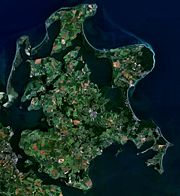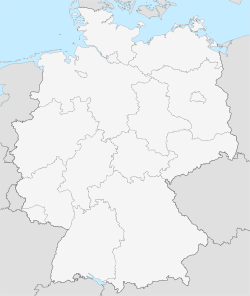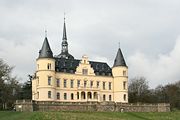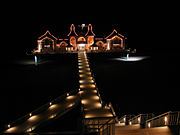Rügen
 Satellite Image of Rügen |
|
| Geography | |
|---|---|
 Rügen (Germany)
|
|
| Location | Baltic Sea |
| Area | 926 km² |
| Country | |
| State | |
| District | Rügen |
| Demographics | |
| Population | 73,000 (as of 2001) |
| Density | 79 people/km2 |
Rügen (IPA: [ˈʁyːgən]) or Rugia is Germany's largest island. It is located in the Baltic Sea off the coast of Mecklenburg-Vorpommern. Rügen makes up the vast part of the Rügen District, which also includes the neighboring islands Hiddensee and Ummanz, as well as several small islands. Rügen is located in one of the most popular holiday and recreation areas within Germany, comprising such seaside resorts as Binz and Sellin and has more tourists per resident than any other location in Germany.
Contents |
Geography
Rügen is located in northeastern Germany in the Baltic Sea and its shape is distinguished by many smaller peninsulas. The Rügendamm bridge, which connects the island by road and rail with the city of Stralsund on the mainland, crosses over the Strelasund. There are also ferry connections from Stralsund, Greifswald and Wolgast.
The climate is in the temperate zone. The winters are not particularly cold with mean temperatures in January and February of 0.0 °C and the summers are cool with mean temperature in August 16.3 °C. There is average rainfall of 520-560 mm and approximately 1800-1870 hours of sunshine annually.
Two of Germany's national parks are on the Isle of Rügen: Vorpommern Lagoon Area National Park in the west (also including Hiddensee) and Jasmund National Park, a smaller park including the famous chalk cliffs (Königsstuhl). There is also nature reserve, Southeast Rügen Biosphere Reserve, consisting of the peninsulas in the southeast.
History


Rügen was first populated about 4000 BC. The migrants were probably members of the Funnelbeaker culture, which exploited Rügen's flint deposits.
In the beginning of the first millennium, the island and the surrounding continental areas were settled by the Germanic Rugians, who might have come from Scandinavia or evolved from autochtone tribes and gave their name to the island. In the 7th century, West Slavic R(uj)ani settled Rügen, assimilating the Germanic population which had not migrated southward in the Migration period, thereby adopting their name (Rugians --> Rujanes). Many traces of their life can be found today. Rügen became a Slavic principality, stretching from the Recknitz to the Ryck River, with the political center in the ancient town of Charenza, and a religious center in the fortified temple of Svantevit at Cape Arkona, the northernmost point of Rügen. In 1168 the area was conquered by Denmark and became the Danish Principality of Rugia. The principality underwent Christianisation and German settlement in the course of the Ostsiedlung. The former monarchs became Danish princes of Rügen. In 1325, Rügen was inherited by the Duchy of Pomerania.
Rügen was a part of Swedish Pomerania from 1648 to 1815; afterwards it became a part of the Prussian Province of Pomerania. In 1816 the first bathing resort was founded at Putbus. Later more resorts were established, and Rügen remained the most famous holiday resort of Germany until World War II.
In 1936 the first bridge connecting Rügen (Rügendamm, recently with a second bridge, Rügenbrücke) with the mainland was constructed, replacing the former ferry shuttles. The Nazis added a large resort: Prora, planned by the Strength Through Joy organisation, which aimed to occupy people's free time. However, Prora was never completed.
Rügen was a major summer holiday destination in the German Democratic Republic. Rügen remained a holiday island after German reunification; it has now surpassed Sylt as the most popular German island again.
In February 2006, dead swans found on Rügen tested positive for H5N1 (the avian influenza virus subtype that is a pandemic threat). A house cat was found dead with the H5N1 strain, marking the first known case of H5N1 in mammals in the European Union.
see also: Rugians, Rani (Slavic tribe), Principality of Rugia, Duchy of Pomerania, Swedish Pomerania, Province of Pomerania, Mecklenburg-Vorpommern
Tourism
Rügen is one of the most requested holiday destinations in Germany. The island has many popular seaside resorts along the eastern coast, such as Binz, as well as quieter locations in the west. Several of the holiday resorts are accessible via a historic narrow gauge railway employing steam locomotives, called Rügensche Kleinbahn. Tourists come both to enjoy the beaches and to explore the island's diverse landscape.
The most popular locations are Binz, Sellin, Sassnitz and Bergen auf Rügen as well as Cape Arkona.


Trivia

The title given to the operation commanded by Wolfram Freiherr von Richthofen which saw the town of Guernica bombed during the Spanish Civil War was named after the island. An Abwehr SIGINT Operation during the same conflict was titled Bodden after the strait separating Rügen from the German mainland.
See also
External links
|
|
Biosphere Reserves in Germany |
|
||
|---|---|---|---|---|
|
||||